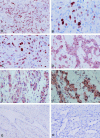MDM-2 oncoprotein overexpression, p53 gene mutation, and VEGF up-regulation in angiosarcomas
- PMID: 9811333
- PMCID: PMC1876718
- DOI: 10.1016/S0002-9440(10)65729-X
MDM-2 oncoprotein overexpression, p53 gene mutation, and VEGF up-regulation in angiosarcomas
Abstract
The endothelium is one of the largest cellular compartments of the human body and has a high proliferative potential. However, angiosarcomas are among the rarest malignancies. Despite this interesting contradiction, data on growth and angiogenesis control mechanisms of angiosarcomas are scarce. In this study of 19 angiosarcomas and 10 benign vascular control lesions we investigated the sequence and expression of the p53 tumor suppressor gene and the expression of the mdm-2 proto-oncogene, which is a negative regulator of p53 activity and of the vascular endothelial growth factor (VEGF), whose expression, among other factors, is regulated by the p53/MDM-2 pathway. Ten sarcomas (53%) exhibited clear nuclear p53 protein accumulation. Two of these cases revealed mutations in the sequence-specific DNA binding domain of the p53 gene. Thirteen angiosarcomas (68%) showed an increased amount of MDM-2 protein. Elevated expression of p53 and MDM-2 protein correlated with increased VEGF expression, which was found in nearly 80% of the angiosarcoma cases. Negative or clearly lower immunostaining was obtained in cases from the benign control collective. Only one case of a juvenile hemangioma reached the cutoff value of p53 positivity coincidentally with high VEGF expression. Our data suggest that the p53/ MDM-2 pathway is impaired in about two-thirds (14/ 19) of the angiosarcomas. This may be a key event in the pathogenesis of human angiosarcomas. The increased VEGF expression observed supports this hypothesis.
Figures



References
-
- Jaffe EA: Cell biology of endothelial cells. Hum Pathol 1987, 18:234-239 - PubMed
-
- Denekamp J: Review article: angiogenesis, neovascular proliferation and vascular pathophysiology as targets for cancer therapy. Br J Radiol 1993, 66:181-196 - PubMed
-
- Folkman J: Seminars in medicine of the Beth Israel Hospital, Boston: clinical applications of research on angiogenesis. N Engl J Med 1995, 333:1757-1763 - PubMed
-
- Malignant vascular tumors. In Soft Tissue Tumors. Edited by FM Enzinger and SW Weiss. Mosby, St. Louis. 1996, 641–677
-
- Levine AJ: p53, the cellular gatekeeper for growth and division. Cell 1997, 88:323-331 - PubMed
MeSH terms
Substances
LinkOut - more resources
Full Text Sources
Research Materials
Miscellaneous

